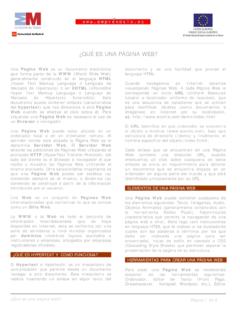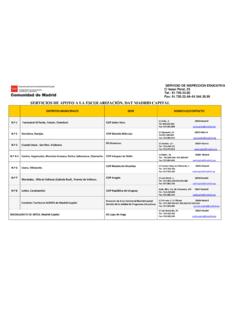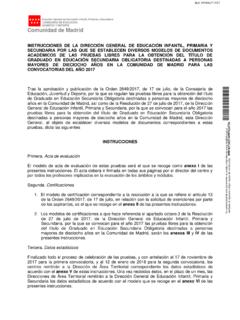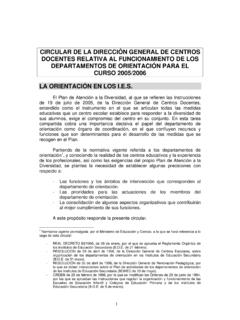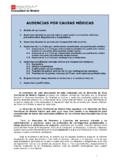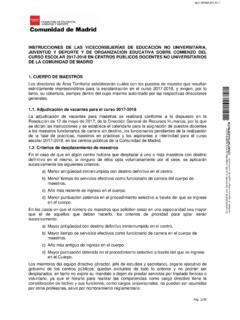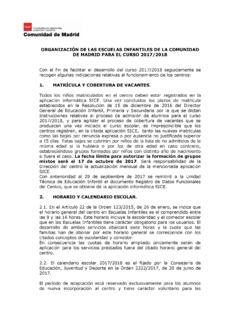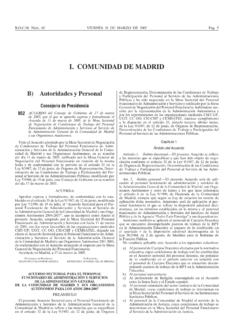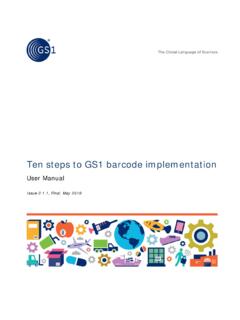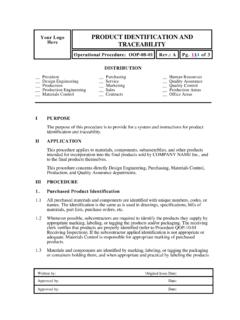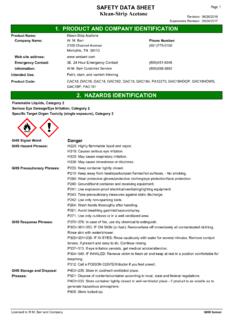Transcription of STAGE 1 : RISK IDENTIFICATION 1. Risk identification 2 ...
1 STAGE 1 : RISK IDENTIFICATIONSTAGE 1 : RISK IDENTIFICATION1. Risk IDENTIFICATION 1. Risk IDENTIFICATION 2. Sources for identifying risks 2. Sources for identifying risks 3. Other procedures for identifying risks3. Other procedures for identifying risks4. Classification of risks4. Classification of risksRisk IdentificationHow can you identify the causes and effects of the risks in your company ?What can happen? In this first STAGE of the methodology, the possible specific causes of business risks are identified in a systematic manner, together with the range and possible effects thereof, which an entrepreneur must confront.
2 The proper IDENTIFICATION of risks calls for a detailed knowledge of the company , of the market in which it operates, of the legal, social, political and cultural environment in which it is set. Risk IDENTIFICATION must be systematic and begin by identifying the key objectives of success and the threats that could upset the achievement of these of the risk:zThe perception of risk as a threatis the system most often used in order to identify it. In this context, managing the risk signifies installing control systems that will minimize both the likelihood that adverse events will occur as well as the severity of such events (the financial loss that would be involved for the entrepreneur).
3 It is a focus of a defensive nature; its aim is to allocate resources in order to reduce the likelihood of sustaining adverse impacts. zFrom the perception of risk as an opportunity, risk management signifies using techniques that will maximize the results, limiting the possible damages or costs. The focus is aggressive in management from the perspective of risk as uncertaintyis aimed at minimizing the deviation between the results that en entrepreneur wishes to obtain and those that he or she actually does for identifying for identifying riskszSources of risk are all of those company environments, whether internal or external, that can generate threats of losses or obstacles for achieving the company s procedure that facilitates the IDENTIFICATION of risks is to ask oneself, with respect to each of the sources.
4 Whether weaknesses or threats exist in each brief list is set out below: Pressure by competitors The employees The customers The new technologies Changes in the environment Laws and regulations Globalization The operations. The IDENTIFICATION of the risk must be systematic and should begin by defining the entrepreneur s objectives, analyzing the factors that are key to the business in order to achieve success and reviewing what the weaknesses of the project are and the threats it has to deal this purpose, it is advisable to make a SWOT analysis(Strengths, Weaknesses, Opportunities and Threats); particularly the weak points and the threats will offer a view of the risks facing the entrepreneur.
5 As an example: proceduresOther of of risks: The purpose of the classification of risks is to show the risks identified in a structured manner, for example, in relation to their origin, as set out in the following :A risk that external factors independent from the entrepreneur s management could directly or indirectly influence the achievement of his or her objectives and strategies to a significant : Strong exposure to regulatory changesBusiness fragmentationAppearance of new marketsOPERATIONAL:The operational risks are associated with the entrepreneur s ability to convert the strategy chosen into specific plans, by means of an effective allocation of : Need for making an advertising effortHigh staffing costsLack of operational and financial planning Tendency toward subcontracting.
6 Tendency towards concentrationTECHNOLOGY:This measures the entrepreneur s exposure to the technological risks derived from the need to undertake heavy investment in order to ensure the feasibility of his or her business project within a specific period of time or the need for training the company s employees in the use of the : Significant investmentsLow level of implementationLow level of technological trainingCOMPETITORS:The size, the financial and operational capacity of the agents in a sector determine the degree of rivalry in that sector and set the rules of the game that any new agent has to consider in order to operate in the marketplace.
7 This can involve risks for the :Appearance of new competitorsIntense competitionSpecialized competitionSUPPLIERS:The role played by the suppliers in the sector could generate risks for an entrepreneur due to variations in the price of raw materials, to the availability of a variety in the supply and for a continuous period of time, as well as the degree of concentration of the suppliers, which will determine the method of payment traditionally accepted in the :Exposure to changes in the price of goods Dispersion in the supplyNon-determination of the quality of the service providedIncrease in power of negotiationCUSTOMERS:The customer can be a crucial focal point of risk for an entrepreneur, since they are the generators of revenues.
8 The risk can stem from changes in their tastes and needs, from generating pressures forcing prices down or from lengthening the payment period, among other factors, in such a way that the entrepreneur s value proposal must always be : Increase in power of negotiationLack of loyaltySocial and demographic changesSeasonality and decline in the demandFINANCIAL:The financial risks refer to the uncertainty associated with effective management and the control of finances carried out by the entrepreneur, as well as to the effects of external factors such as the availability of credit, exchange rates, movements in interest rates, :Long-term financial incapacityExposure to interest rate changesLack of knowledge of advantageous sources of financing, subsidies, etc
